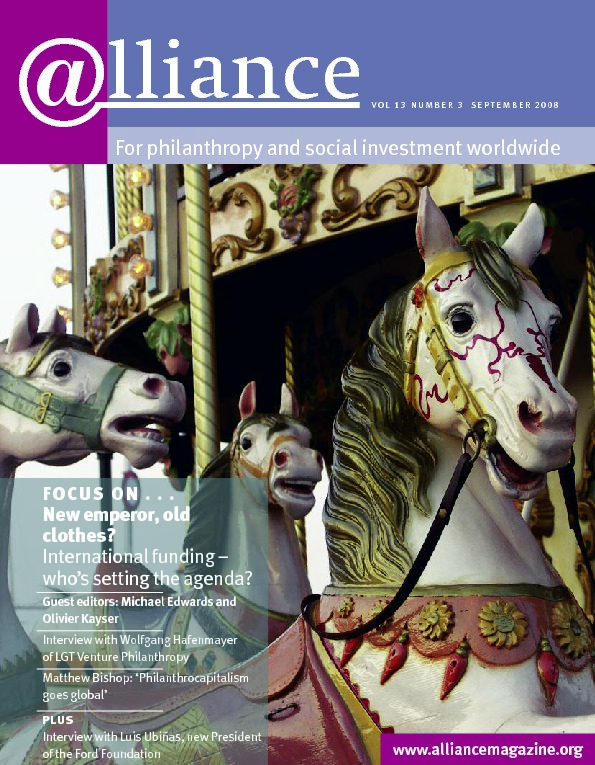 Whenever there is an economic downturn, or whenever a major problem catches the fancy of a critical mass of people, a cry goes up that the foundation world must do something to address the issue. Such is the case now as we face a prolonged and deeper economic crisis than at any time since the 1930s, and such has been the case in the past when it came to dealing with AIDS or climate change, for example.
Whenever there is an economic downturn, or whenever a major problem catches the fancy of a critical mass of people, a cry goes up that the foundation world must do something to address the issue. Such is the case now as we face a prolonged and deeper economic crisis than at any time since the 1930s, and such has been the case in the past when it came to dealing with AIDS or climate change, for example.
For the most part, this cry that the foundation world do something takes the form of increasing the normal or the state-mandated minimum payout. It is perhaps more keenly felt in the US where the legal payout requirement tends to be steeper than it is in other places, but it is indeed felt in many places beyond the US.
Before we go any further, let’s take a moment to deal with the rationale behind setting a payout level and say a few words about the level itself. Many scholars, statisticians and practitioners have been able to make a substantial three-course meal out of a fairly straightforward and easily explained notion. Essentially, a foundation gets an exemption from taxes and the state treasury forgoes a source of income because there is a presumption that the foundation will disburse its resources, usually in the form of grants, for initiatives that have public benefit. And, since a foundation can’t make a contribution to public benefit if it’s ‘sitting on its assets’, a payout regime is needed.
The payout level itself differs in different countries for historical, cultural and political reasons, but I think it is safe to say that it is attracting more attention than ever before and the thrust is towards pushing payout up to a level that is more intuitively in tune with the level of exemption received. I would argue that for foundations that seek to operate in perpetuity, the payout level should not exceed an amount that allows the foundation to protect its purchasing power over time from the ravages of inflation. While it is unseemly to hoard earnings and capital gains beyond that necessary to stay even, and warehousing wealth is inappropriate, preserving purchasing power is not.
In the US we know from over 100 years of collecting data that the asset class that brings the greatest return is equities and that on average that return is a bit more than 8 per cent per annum. We also know from some 50 years of data collecting that the average inflation rate is about 3 per cent per annum. That means a portfolio heavily invested in the equities market can pay out around 5 per cent a year and still retain the purchasing power of the endowment over time. For those who would chastise foundations in the US for sticking to the state-mandated 5 per cent payout requirement, I would argue that foundations that seek to exist in perpetuity and still preserve the purchasing power of their endowment cannot afford to vary significantly from the 5 per cent payout requirement.
Now back to our story line: should we increase the payout rate during the current economic crisis? As long as each foundation answers that question for itself and the decision is not one mandated by the state that in effect puts perpetuity out of the question as one model of organized philanthropy, either answer is legitimate. I say this because one of the great strengths of organized philanthropy is found in the diversity of models employed and in the diversity of programmes supported. If one defines philanthropy as ‘the voluntary capture of private wealth for public benefit’, then it stands to reason that the greater the menu of models available for people to choose from, the greater the chance they will find one to work through that they are comfortable with.
If you’re part of the increasingly fashionable ‘give while you live’ movement, that is fine. If you believe that foundations should not exist in perpetuity and set a sunset provision on the life of your foundation, that is fine. But it is also fine to want to make a cross-generational statement and seek to have your foundation exist in perpetuity with the purchasing power of its endowment intact.
Finally, it goes without saying that it is also fine to change your mind and either move towards or away from perpetuity. What is counterproductive is having the state make the decision in such a way that perpetuity is taken off the table. One size may fit all in some types of clothing, but not in philanthropy.
Barry D Gaberman can be contacted at bgaberman@gmail.com


Comments (0)